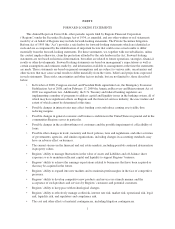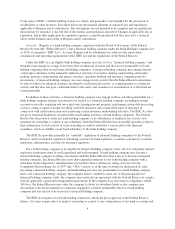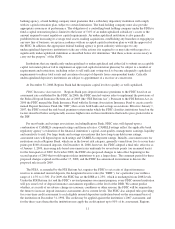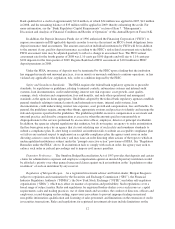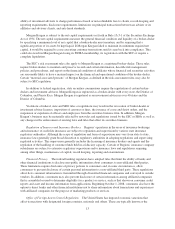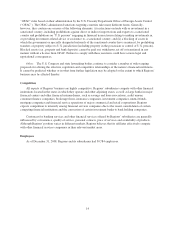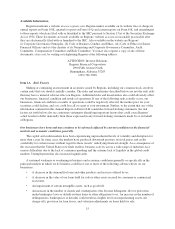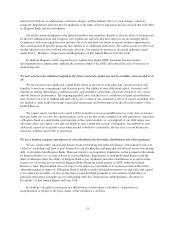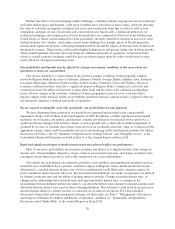Regions Bank 2008 Annual Report Download - page 20
Download and view the complete annual report
Please find page 20 of the 2008 Regions Bank annual report below. You can navigate through the pages in the report by either clicking on the pages listed below, or by using the keyword search tool below to find specific information within the annual report.to be incurred, by the FDIC due to the default of any other insured depository institution controlled by that
holding company and for any assistance provided by the FDIC to any of those banks that is in danger of default.
Such a “cross-guarantee” claim against a depository institution is generally superior in right of payment to claims
of the holding company and its affiliates against that depository institution. At this time, Regions Bank is the
only insured depository institution controlled by Regions for this purpose. If in the future, however, Regions
were to control other insured depository institutions, such cross-guarantee would apply to all such insured
depository institutions.
Transactions with Affiliates. There are various legal restrictions on the extent to which Regions and its
non-bank subsidiaries may borrow or otherwise obtain funding from Regions Bank. Under Sections 23A and 23B
of the Federal Reserve Act and the Federal Reserve’s Regulation W, Regions Bank (and its subsidiaries) may
only engage in lending and other “covered transactions” with non-bank and non-savings bank affiliates to the
following extent: (a) in the case of any single such affiliate, the aggregate amount of covered transactions of
Regions Bank and its subsidiaries may not exceed 10% of the capital stock and surplus of Regions Bank; and
(b) in the case of all affiliates, the aggregate amount of covered transactions of Regions Bank and its subsidiaries
may not exceed 20% of the capital stock and surplus of Regions Bank. Covered transactions also are subject to
certain collateralization requirements. “Covered transactions” are defined by statute to include a loan or
extension of credit, as well as a purchase of securities issued by an affiliate, a purchase of assets (unless
otherwise exempted by the Federal Reserve) from the affiliate, the acceptance of securities issued by the affiliate
as collateral for a loan, and the issuance of a guarantee, acceptance or letter of credit on behalf of an affiliate. All
covered transactions, including certain additional transactions, (such as transactions with a third party in which
an affiliate has a financial interest) must be conducted on market terms.
Regulatory Remedies under the FDIA. The FDIA establishes a system of regulatory remedies to resolve
the problems of undercapitalized institutions. The federal banking regulators have established five capital
categories (“well capitalized,” “adequately capitalized,” “undercapitalized,” “significantly undercapitalized” and
“critically undercapitalized”) and must take certain mandatory supervisory actions, and are authorized to take
other discretionary actions, with respect to institutions in the three undercapitalized categories, the severity of
which will depend upon the capital category in which the institution is placed. Generally, subject to a narrow
exception, the FDIA requires the banking regulator to appoint a receiver or conservator for an institution that is
critically undercapitalized. The federal banking agencies have specified by regulation the relevant capital level
for each category.
Under the agencies’ rules implementing the FDIA’s remedy provisions, an institution that (1) has a Total
Capital ratio of 10.0% or greater, a Tier 1 Capital ratio of 6.0% or greater, and a Leverage Ratio of 5.0% or
greater and (2) is not subject to any written agreement, order, capital directive or regulatory remedy directive
issued by the appropriate federal banking agency is deemed to be “well capitalized.” An institution with a Total
Capital ratio of 8.0% or greater, a Tier 1 Capital ratio of 4.0% or greater, and a Leverage Ratio of 4.0% or greater
is considered to be “adequately capitalized.” A depository institution that has a Total Capital ratio of less than
8.0%, a Tier 1 Capital ratio of less than 4.0%, or a Leverage Ratio of less than 4.0% is considered to be
“undercapitalized.” An institution that has a Total Capital ratio of less than 6.0%, a Tier 1 Capital ratio of less
than 3.0%, or a Leverage Ratio of less than 3.0% is considered to be “significantly undercapitalized,” and an
institution that has a tangible equity capital to assets ratio equal to or less than 2.0% is deemed to be “critically
undercapitalized.” For purposes of the regulation, the term “tangible equity” includes core capital elements
counted as Tier 1 Capital for purposes of the risk-based capital standards plus the amount of outstanding
cumulative perpetual preferred stock (including related surplus), minus all intangible assets with certain
exceptions. A depository institution may be deemed to be in a capitalization category that is lower than is
indicated by its actual capital position if it receives an unsatisfactory examination rating.
An institution that is categorized as undercapitalized, significantly undercapitalized or critically
undercapitalized is required to submit an acceptable capital restoration plan to its appropriate federal banking
agency. Under the FDIA, in order for the capital restoration plan to be accepted by the appropriate federal
10



